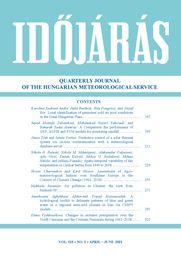IDŐJÁRÁS - angol nyelvű folyóirat
Vol. 125, No. 2 * Pages 167–336 * April - June 2021
 |
|
 letöltés [pdf: 4520 KB]
letöltés [pdf: 4520 KB]
Local identification of persistent cold air pool conditions in the Great Hungarian Plain
Karolina Szabóné André, Judit Bartholy, Rita Pongrácz, and József Bór
DOI:10.28974/idojaras.2021.2.1 (pp. 167–192)
Karolina Szabóné André, Judit Bartholy, Rita Pongrácz, and József Bór
DOI:10.28974/idojaras.2021.2.1 (pp. 167–192)
IDŐJÁRÁS folyóirat

Az IDŐJÁRÁS a HungaroMet Nonprofit Zrt. negyedévenként megjelenő angol nyelvű folyóirata
Megrendelhető a journal.idojaras@met.hu címen.
A szerzőknek szánt útmutató itt olvasható.
Megrendelhető a journal.idojaras@met.hu címen.
A szerzőknek szánt útmutató itt olvasható.









